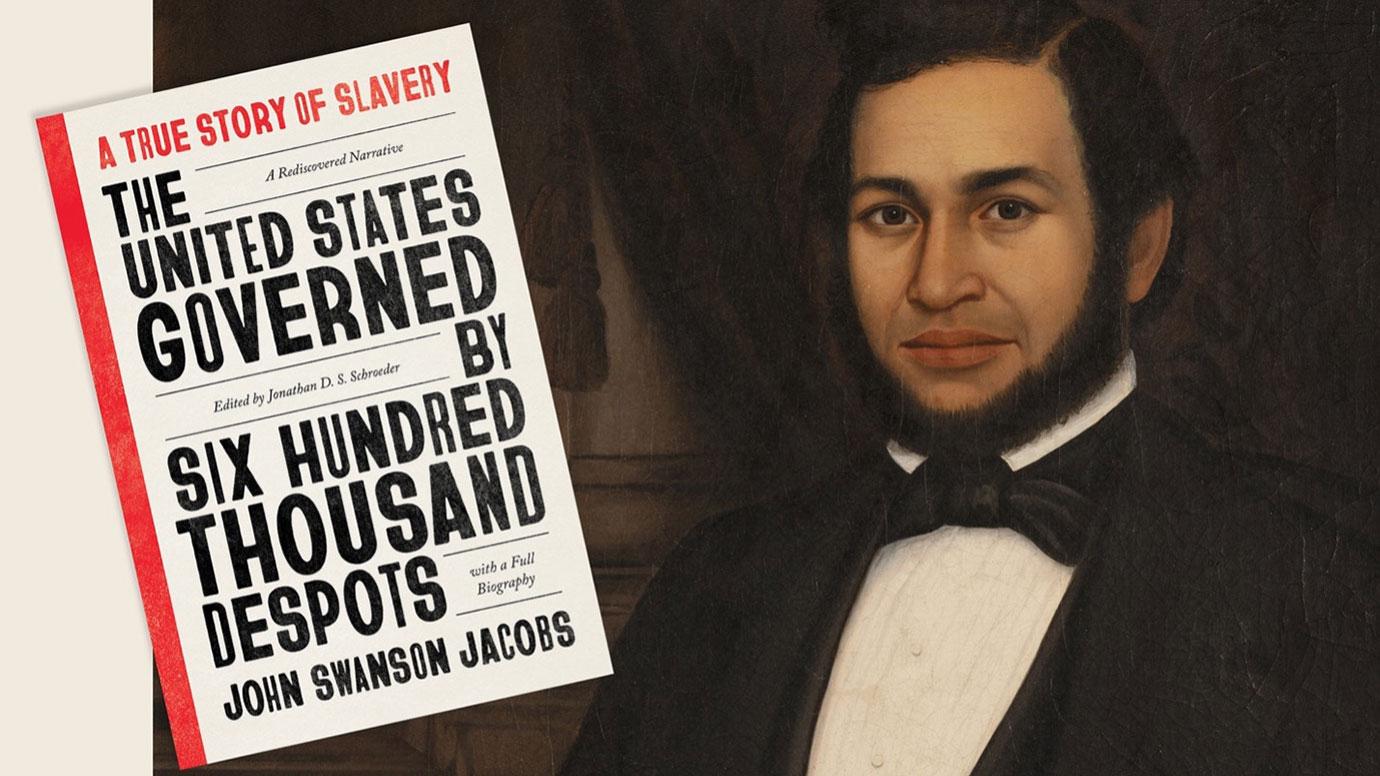In 2016, a University of Chicago scholar stumbled across an extraordinary piece of writing that had been lost for nearly two centuries—one of the few firsthand book-length accounts of slavery, and fewer still that weren’t shaped by white editors.
Written by John Swanson Jacobs, a man who had escaped slavery in North Carolina, learned to read and write, and traveled the world, the piece was published in an Australian newspaper in 1855. The Fugitive Slave Act of 1850 meant Jacobs was at risk of being returned to slavery in the United States, but in Australia, Jacobs was free—and he could write his story exactly as he saw fit.
This summer, the first stand-alone edition of The United States Governed by Six Hundred Thousand Despots: A True Story of Slavery; A Rediscovered Narrative, with a Full Biography, was published by the University of Chicago Press. For the republication, Jonathan D. S. Schroeder, PhD'16, gathered Jacobs’s letters and other writings, wrote a detailed biography of Jacobs, and even identified a painting he believes depicts Jacobs.
Together, the materials tell the story of a fiercely intelligent man intent on denouncing the injustice at the heart of his country and articulating the urgent need for abolition. “The day must come; it will come,” Jacobs writes in Despots. “Human nature will be human nature; crush it as you may, it changes not; but woe to that country where the sun of liberty has to rise up out of a sea of blood.”
The rediscovery and republication of the text is “an extraordinary contribution to the canon of slave narratives—thus a contribution to American history and to the history of the Black diaspora,” says Bill Brown, Karla Scherer Distinguished Service Professor in American Culture and one of Schroeder’s UChicago advisers.
Despots stands out, he said, “for all the reasons that Jon outlines in his introduction to the work—the absence of a White abolitionist mediator, the aggressive tone, the full-frontal attack on US political institutions. … It will be read and reread, studied, and cherished for its detailed belligerence.”
“It will be read and reread, studied, and cherished for its detailed belligerence.”
A singular piece of writing
In 2016 Schroeder, who had recently completed his PhD in English at UChicago, was engaged in one of the many side quests that inevitably accompany academic research.
His dissertation focused on the term ‘nostalgia,’ which in the 18th century was a medical diagnosis of pathological homesickness, often applied to displaced and marginalized groups. For a chapter about how enslaved and formerly enslaved people experienced what doctors then called nostalgia, he had been reading about Harriet Jacobs, author of the 1861 autobiography Incidents in the Life of a Slave Girl, Written By Herself.

While searching for information about the fate of Jacobs’ son, Schroeder turned up something else entirely: a 20,000-word article from April 1855 in the Sydney newspaper the Empire, published under the title “The United States Governed by Six Hundred Thousand Despots” and written by Harriet’s brother, John Swanson Jacobs.
Schroeder had never seen the document referenced anywhere, and he felt its importance instantly. This was a singular piece of writing, one that differed in striking ways from other accounts from the same period written by formerly enslaved people. Part autobiography, part polemic, the furious narrative seemingly took its title from Jacobs’s estimate of the number of slave owners in the United States at that time.
From Despots and other sources, Schroeder was able to reconstruct a remarkably comprehensive account of Jacobs’s life.
‘No longer yours’
“My father taught me to hate slavery; but forgot to teach me how to conceal my hatred,” Jacobs writes in Despots. Born into slavery sometime between 1815 and 1819, he resisted in whatever small ways he could—for example, by refusing to call his enslaver’s children “Master” and “Miss.”
Escape became Jacobs’s ultimate ambition. He’d seen others in his family take the risk. His uncle successfully escaped; his sister, Harriet, went into hiding in 1835.
Jacobs finally took his chance in 1839 when his then-enslaver, the North Carolina congressman Samuel Tredwell Sawyer, brought Jacobs along on a trip to New York. While there, Jacobs slipped out and boarded a steamship bound for Providence, Rhode Island. (He’d secretly sold his best clothes to pay for the ticket.) As he could read but not write at the time, he instructed a friend to send a note to Sawyer on his behalf. It concluded simply, “No longer yours, John S Jacob [sic].”
Like many other men in his position, Jacobs went to sea after his escape, spending three and a half years aboard the Frances Henrietta. He studied in his spare time on board, teaching himself to write and reading abolitionist literature. In 1843 Jacobs returned and became active on the abolitionist lecture circuit, befriending figures including Frederick Douglass and William Cooper Nell.

This fruitful period in Jacobs’s life was cut short in 1850 by the passage of the second Fugitive Slave Act. The legislation permitted the seizure of escaped slaves, even in free states and without due process, extending the legal reach of slavery and threatening the already fragile compromise between slave and free states. The new law was intensely divisive; many historians see it as having put the nation on the path to war. Jacobs felt in real peril of being forcibly returned to North Carolina.
He headed west to mine in gold-rush California, where the new legislation did not yet apply. But his respite was brief: in 1852 California passed its own fugitive slave law. Jacobs set out for Australia, the country in which he would write and publish Despots. Jacobs was among the estimated 5 percent of Black Americans who left the United States after 1850.
Schroeder sees these years as intensely formative for Jacobs. As fugitive slave laws spread, the possibility of remaining in his home country was taken from him. “I think that the tone of Despots is related to the passage of the second Fugitive Slave Act,” Schroeder says. “It seems doubtless that this radicalized him.”
‘Invisible constraints’
There are about 6,000 extant slave narratives, the majority of which are audio recordings collected in the 1930s through the Works Progress Administration; there are only about 200 book-length narratives like Despots.
Schroeder had never seen the document referenced anywhere, and he felt its importance instantly.
Yet these texts, especially the ones from the 19th century, were shaped by certain “invisible constraints,” as Schroeder puts it. White abolitionist editors wanted particular kinds of stories: the slave narratives that got published tended to follow a standard arc from birth to escape and included graphic details of barbarity intended to arouse outrage and sympathy.
Harriet Jacobs’s Incidents in the Life of a Slave Girl—which was heavily shaped by its white editor, Lydia Maria Child—conforms in many ways to this pattern. Child also excised material from Harriet’s manuscript, including a chapter on the radical abolitionist John Brown, that brought focus to the political, rather than personal, aspects of her story.
Jacobs’s tone is forceful and unsentimental; rather than detailing the cruelties inflicted on him, he focuses his attention on the people and institutions that allowed the injustice of slavery to continue. In the last several sections, Jacobs eschews conventional autobiography, moving away from his life story and toward a methodical, point-by-point argument for abolition.
“The people of the north cannot plead ignorance to the sin of slavery,” Jacobs writes. Since the passage of the 1850 Fugitive Slave Act, “they can no longer say, ‘This sin does not lie at my door;’ they can no longer say, ‘I am not my brother’s keeper.’ The blood of your coloured countrymen cries out against you—the laws of God condemn you.”
Leaving Australia, Jacobs settled in London and resumed his career as a sailor. Jacobs crisscrossed the globe, visiting the Caribbean, South America, and the Middle East. He used his unusual vantage point to help the abolitionist cause, writing letters to friends and antislavery organizations about the shifting attitudes toward slavery around the world as well as the trade in Chinese indentured servants. As Schroeder puts it, “he was the abolitionists’ eyes and ears on the world.”
A sense of absence

Schroeder, who is currently a lecturer at the Rhode Island School of Design, hopes to write a multigenerational biography of the Jacobs family.
Despite all we now know about the life of John S. Jacobs, there is much we still do not. Schroeder says he is continually struck by this sense of absence.
In the records that survive, people like Jacobs are “not given individuality. They’re treated as a population to be measured by the Census, and then multiplied by three-fifths,” Schroeder says.
Who they were, what mattered to them, what meaning they made of their lives: these questions remain unanswered.
— Adapted from a story that first appeared in the University of Chicago Magazine. Read it in its entirety here.









